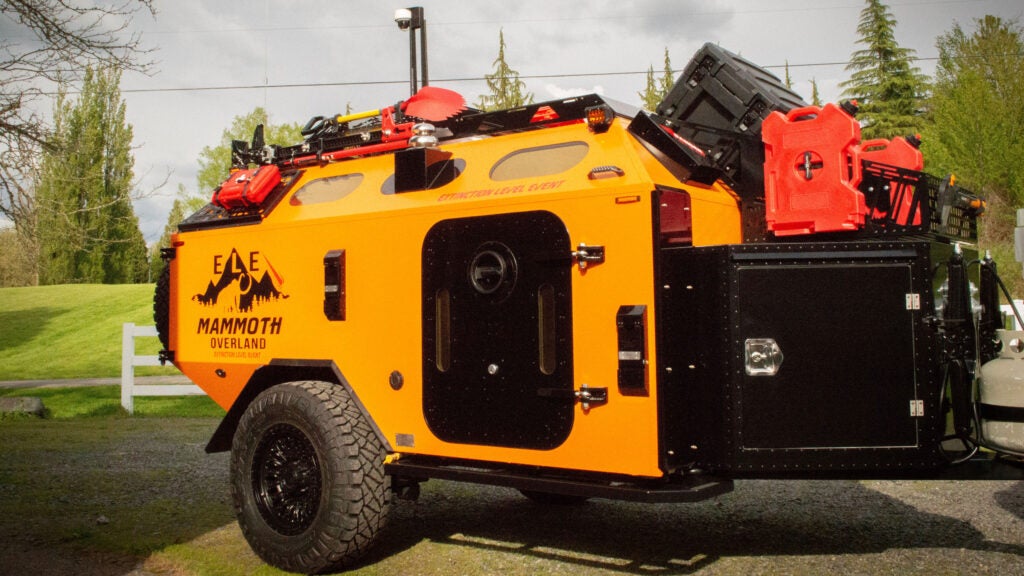No products in the cart.
Outdoor Adventure
Overlanding Has Finally Gone Too Far
When I first saw an email from Mammoth Overland about their new ELE off-road trailer I immediately looked at the date. Was it April first? Were they kidding? Was this some kind of joke I was too old or too stupid to get?
The email explained that ELE stands for “Extinction-Level Event” and went on to detail how the trailer can be specced with a defense system that shoots out bear spray, optional bulletproofing, and a drone launch system—features so outrageous I thought someone was pulling my chain.
Turns out Mammoth is serious. The ELE trailer is a real thing and comes as a prepper basement on wheels that’s so fortified it could guard against attacks from wildlife, zombies, or other unknown threat I can’t conjure.
As I tried to get my head around it, my first thought was of the old-schoolers from Australia, South Africa, and the United Kingdom who invented overlanding. Those folks, who became the overland OGs by taking their old, beat-up Land Rovers into the wild areas of their countries to see what they could see, would surely marvel at what overlanding has become. They’d laugh, I assume, at a trailer that is so overbuilt that it becomes a marketing gimmick instead of a tool used to enjoy the outdoors.
My next thought was that even though the ELE trailer is way over the top, overlanding has admittedly been heading in this overdone, over-prepared direction for a while. I regularly see overland vehicles that are stacked with huge rock-crawling tires, enough suspension to race the Baja 1000, and every recovery tool on the market. While some of these owners use every bit of that gear, many don’t. They might drive up fire roads and enjoy the outdoors, but all you need for a fire road is a Subaru Outback, not a $100,000 overland build.
Of course, it’s been said, “Let he who is without sin cast the first stone.” I, too, am guilty of embracing and promoting excess preparation. Ever since overlanding—which at its base is defined as vehicle-based exploration and camping—started to get popular in the U.S. about a decade ago, I’ve been part of the community that’s charged forward to grow the activity.
I’ve been at the past six Overland Expo West events—the biggest gear show for overlanding—and cheered each year as it grew. I’ve walked the shows to find, photograph, and write about brand new overlanding gadgets that help us travel farther afield in our overlanding rigs and will help us stay safe and camp with increased comfort and convenience.
I used to be one of the overland geeks who I’m accusing of going too far with their prepper mentality. I built that same overloaded rig I now criticize. Eventually, my Tacoma just sat around because I couldn’t pull off the epic adventures I’d dreamed of, and it was overkill for an easy weekend in the backcountry. And, I’ll admit that mostly I liked how it looked and the ego boost it gave me while driving around town.
But having watched this overlanding excess spread, and in an effort to put my ego in check and reclaim my rig for its intended use, I’ve since backed off. Nowadays, I spend much more time thinking about what gear I actually need to access the places I want to see, stay safe, and camp comfortably. If the gear doesn’t doesn’t meet one of those qualifications, then it doesn’t belong in my kit. Less gear means less time dealing with my truck and more time actually adventuring.
I’ve never used a Mammoth trailer, but I see the appeal of the platform. Trailers help enormously with organization. Instead of trying to carry all your overlanding gear in or on your vehicle, much of it can ride in the trailer, keeping your overland rig lighter and clutter-free. A trailer also adds sleeping space, and being able to leave your stuff in a trailer instead of a garage helps get you out the door more quickly.
It seems like Mammoth makes a quality product. I’d gladly test one of their normal trailers. But as hard as I might try, I cannot think of anyone who needs a drone launch platform on their teardrop trailer. There are, of course, people who will disagree with me about that, and maybe this trailer is for them.
Instead of spending $92,000 on a bulletproof ELE, however, I might suggest folks invest in classes and adventures. The Overland Expos that are now held around the country offer tons of useful classes on everything from driving to recovery, and that’s how you’ll learn what gear you actually need, and what gear is overkill.
As I’ve also heard many times from highly experienced overlanders: adventuring is the best tool for building your rig. Start simple—maybe some all-terrain tires and Maxtrax—and then head out and see what happens. If you realize that driving high-consequence roads scares you, and you’re better suited to fire roads, then you’re not going to need a lot of extra overlanding gear. But if you want to keep pushing you’ll quickly learn what gear you’ll need in order to access, enjoy, and return from the places you want to explore—without spending tens of thousands of dollars on a rig that has its own video surveillance system.
Source link

